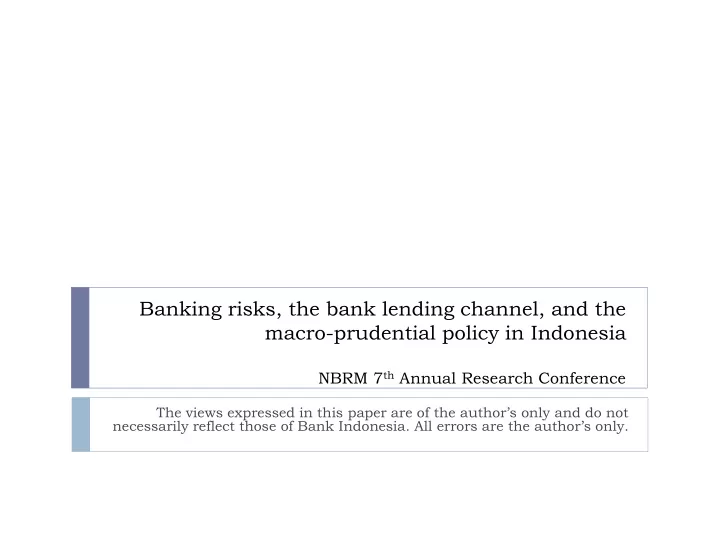

Banking risks, the bank lending channel, and the macro-prudential policy in Indonesia NBRM 7 th Annual Research Conference The views expressed in this paper are of the author’s only and do not necessarily reflect those of Bank Indonesia. All errors are the author’s only.
Motivation • Credit growth is a key driver for economy growth. • Low credit growth may hamper the economy growth, but excessive growth may fuel greater risks for macro and financial stability. • Effectiveness of monetary and macro-prudential polices to manage credit growth. Graph 1. Credit/GDP Major Asia Countries Graph 2. Indonesia credit, GDP growth, BI rate Data sources: BIS statistics and Bank Indonesia Data Sources: BIS statistics and Bank Indonesia The blue rectangular boxes represent loosening periods while the red rectangular box indicates tightening periods of macro-prudential policy.
Objective & Research questions What factors drive credit growth in Indonesia? Liquidity? Capital? Credit risk? Monetary interest rate policy (bank lending channel)? Macro-prudential policy? Interaction of banking characteristics with macro-prudential policy? Interaction of monetary and macro-prudential policy?
Literature review Credit growth & monetary policy (bank lending channel) Bernanke&Blinder (1992), Kashyap&Stein (1994), Morris&Sellon (1995), Gambacorta & Marques-Ibanez (2011). Credit growth & macro-prudential policy cross countries evidence: Claessens, et al (2011), Lim, et al (2011), Zhang&Zoli (2014), Cerutti, et al (2017), case study of a country: Igan&Kang (2011), Wong, et al (2011), Jimenez, et al (2012), Aiyer, et al (2014). Credit growth & banking characteristics (liquidity, credit risk, sources of financing, capital) Bernanke & Lown (1991), Peek & Rosengreen (1995), Kashyap, et al (2002), Cornett, et al (2010), Gambacorta & Marques-Ibanez (2011), Kapan & Minoiu (2013), Klein (2013), Accornero, et al (2017).
The Model Expanding Kashyap & Stein (1994) ∆𝑚𝑝 𝑑𝑠𝑓𝑒𝑗𝑢 𝑗𝑢 = 𝜄∆𝑚𝑝 𝑑𝑠𝑓𝑒𝑗𝑢 𝑗𝑢−1 + 𝛿∆𝑚𝑝 𝐻𝐸𝑄 𝑢−𝑙 + 𝛽∆𝑚𝑝 𝐷𝑄𝐽 𝑢−𝑙 + 𝛾∆𝐷𝐶 𝑢−𝑙 ∗ 𝑁𝑄𝐽1 𝑢−𝑙 ∆𝐷𝐶 𝑢−𝑙 + 𝜀𝑌 𝑗𝑢−𝑙 + 𝜒 1 𝑁𝑄𝐽1 𝑢−𝑙 + 𝜒 2 𝑁𝑄𝐽2 𝑢−𝑙 + 𝛾 1 ∗ 𝑁𝑄𝐽2 𝑢−𝑙 ∆𝐷𝐶 𝑢−𝑙 + 𝜀 1 ∗ 𝑁𝑄𝐽1 𝑢−𝑙 𝑌 𝑗𝑢−𝑙 + 𝜀 2 ∗ 𝑁𝑄𝐽2 𝑢−𝑙 𝑌 𝑗𝑢−𝑙 + 𝜁 𝑗𝑢 + 𝛾 2 ∆𝑚𝑝 𝑑𝑠𝑓𝑒𝑗𝑢 𝑗𝑢 ∶ quarterly changes of log nominal credit bank 𝑗 at period 𝑢 Quarterly macro-economic and individual data of 94 Indonesian commercial banks over the period of 2005-2016.
Variables (1) MPI1: dummy variables of phase 1 macro-prudential policy (MP) Code 1 for loosening period Q1 2011-Q2 2012 , code -1 for tightening period Q3 2012-Q2 2015, and 0 otherwise. MPI 2: dummy variables of phase II macro-prudential policy (MP) Code 1 for loosening period Q3 2015 - Q4 2016 and 0 otherwise
Variables (2) Independent Variables’ description Expected variables sign LA/D The ratio of liquid assets (cash, + placement at the central bank, and high-grade securities) to deposit (%). NPL The ratio of the non-performing - loans to total loan (%). Cap_buffer Deviation of realized Capital +/- Adequacy Ratio (CAR) to minimum capital requirement ratio (%). Asset_shr The ratio of a bank asset to total +/- industry asset (%). It is adjusted to total industry asset in each period to account for possible time trend. Δlog(GDP) The quarterly change of log of gross + domestic product. Δ CB The quarterly change of monetary - interest rate policy BIrate. Δlog(CPI) The quarterly change of log of +/- Consumer Price Index
Methodology Dynamic panel model: Two-step Arellano-Bover/Blundell-Bond Generalized Method of Moments (GMM). A consistent estimator, subject to: 𝜄 of ∆𝑚𝑝 𝑑𝑠𝑓𝑒𝑗𝑢 𝑗𝑢−1 of GMM lies between those of FELS (downward bias) and OLS (upward bias) (Bond (2002), Roodman (2006)). Otherwise, utilize FELS with Nickel bias 1 𝑈−1 For large 𝑈 , dynamic panel bias is insignificant, Number of instruments tend to explode with 𝑈 (Roodman, 2006). Endogeneity : utilizing lagged of explanatory variables
Main Result 1: credit growth of all banks Note: *, **, *** indicate Note: *, **, *** indicate statistical significance statistical significance at the at the level of 10%, 5%, and 1%, respectively level of 10%, 5%, and 1%, respectively
Main Result 2: credit growth of large vs. small banks Note: *, **, *** indicate statistical significance at the level of 10%, 5%, and 1%, respectively
Main Result 3: post GFC 2008/09 evaluation Note: *, **, *** indicate statistical significance at the level of 10%, 5%, and 1%, respectively
Supporting explanation: credit risk Note: *, **, *** indicate statistical significance at the level of 10%, 5%, and 1%, respectively 𝑶𝑸𝑴 𝒋𝒖 Note: dependent variable is 𝒎𝒑𝒉𝒋𝒖 𝑶𝑸𝑴 = 𝒎𝒑𝒉( 𝟐−𝑶𝑸𝑴 𝒋𝒖 ) . *, **, *** indicate statistical significance at the level of 10%, 5%, and 1%, respectively
Indonesia case: A rise of risk-averse behaviour due to higher credit risk & liquidity pressure in the midst of economic slowdown leads to substantial lower credit growth despite the loosening policies. Graph 4. Retail interest rates and Graph 3. Liquidity, credit risk, & credit Graph 3. Credit risk, liquidity, & capital Graph 4. Credit growth, GDP, & BIrate monetary (BI) rate growth buffer Data sources: Bank Indonesia and Financial Service Authority (OJK) The first and second blue rectangular box represents phase I and II of loosening MP, respectively, while the red rectangular box indicates phase I of tightening MP policy .
Conclusion Post the GFC 2008/09, the role of monetary interest rate policy on the bank lending diminishes and affect credit growth indirectly through its stronger impact on credit risk. The effectiveness of loosening macro-prudential policies to improve credit growth is subject to bank’s risk condition. The ineffectiveness of both loosening monetary and macro-prudential policies to improve credit growth since 2015 is due to intensifying of banking risk-averse behavior. Banks choose to have higher liquidity and stronger capital buffer to anticipate higher credit risk in the midst of economic slowdown, leading to substantial lower credit growth. Policy challenges in Indonesia are to encourage banks to improve their risks management and address a sensible balance of the trade-off between banks’ risks and their role in intermediating funds.
Appendix 1: Descriptive statistics
Recommend
More recommend